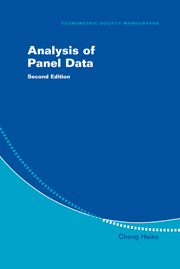Book contents
- Frontmatter
- Contents
- Preface to the Second Edition
- Preface to the First Edition
- Chapter 1 Introduction
- Chapter 2 Analysis of Covariance
- Chapter 3 Simple Regression with Variable Intercepts
- Chapter 4 Dynamic Models with Variable Intercepts
- Chapter 5 Simultaneous-Equations Models
- Chapter 6 Variable-Coefficient Models
- Chapter 7 Discrete Data
- Chapter 8 Truncated and Censored Data
- Chapter 9 Incomplete Panel Data
- Chapter 10 Miscellaneous Topics
- Chapter 11 A Summary View
- Notes
- References
- Author Index
- Subject Index
Chapter 6 - Variable-Coefficient Models
Published online by Cambridge University Press: 14 May 2010
- Frontmatter
- Contents
- Preface to the Second Edition
- Preface to the First Edition
- Chapter 1 Introduction
- Chapter 2 Analysis of Covariance
- Chapter 3 Simple Regression with Variable Intercepts
- Chapter 4 Dynamic Models with Variable Intercepts
- Chapter 5 Simultaneous-Equations Models
- Chapter 6 Variable-Coefficient Models
- Chapter 7 Discrete Data
- Chapter 8 Truncated and Censored Data
- Chapter 9 Incomplete Panel Data
- Chapter 10 Miscellaneous Topics
- Chapter 11 A Summary View
- Notes
- References
- Author Index
- Subject Index
Summary
INTRODUCTION
So far we have confined our discussion to models in which the effects of omitted variables are either individual-specific or time-specific or both. But there are cases in which there are changing economic structures or different socioeconomic and demographic background factors that imply that the response parameters may be varying over time and/or may be different for different cross-sectional units. For example, in Chapter 2 we reported a study (Kuh (1963)) on investment expenditures of 60 small and middle-sized firms in capital-goods-producing industries from 1935 to 1955, excluding the war years (1942–1945). In a majority of the cases Kuh investigated, the hypothesis of common intercept and slope coefficients for all firms, as well as that of variable intercept but common slope, was rejected (Tables 2.3 and 2.4). Similar results were found by Swamy (1970), who used the annual data on 11 U.S. corporations from 1935 to 1954 to fit the Grunfeld (1958) investment functions. His preliminary test of a variable intercept but common coefficients for the value of a firm's outstanding shares at the beginning of the year and its beginning-of-year capital stock yielded an F value of 14.4521. That is well above the 5 percent value of an F distribution with 27 and 187 degrees of freedom.
When data do not support the hypothesis of coefficients being the same, yet the specification of the relationships among variables appears proper or it is not feasible to include additional conditional variables, then it would seem reasonable to allow variations in parameters across cross-sectional units and/or over time as a means to take account of the interindividual and/or interperiod heterogeneity.
- Type
- Chapter
- Information
- Analysis of Panel Data , pp. 141 - 187Publisher: Cambridge University PressPrint publication year: 2003
- 2
- Cited by



